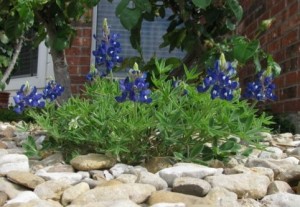
…
One of the most distinctive symbols of Texas, besides the Lone Star flag, is Lupinus texensis, the bluebonnet. Our state flower thrives in poor, rocky soil and tolerates drought pretty well, which probably explains why it is the state flower of Texas and not of, say, Florida or Louisiana. Since the plant lives only one year it must re-seed itself each season. It does so quite efficiently, thanks to its ingeniously-designed seed pods. When the seeds are mature, the pods dry out and burst apart, flinging seeds all over.
We have two flower beds in our back yard where I try to encourage bluebonnets: one by the house, the other along the back fence. I rescue stray seeds from the sidewalk and poke them into flowerbed soil where they will have a chance to sprout. So where do the most bluebonnets come up each fall? Right — the vegetable garden, of course. Never fails.
First I tried letting the vegetable-garden bluebonnets grow, bloom and go to seed, thinking I would capture all the seeds so the same thing wouldn’t happen next year. Hah. You can never catch them all. So last summer, I decided No more Mrs. Nice Gardener. I would put a stop to Bluebonnet Encroachment.
I really love the plants and would hate to lose any of them, so I decided to dig them up — not pull them up — and transplant them to the nice, rocky, sunny flower bed where I could enjoy them. My trusty trowel and I got out there one hot day. I cleared some spots among the river rock in the flower bed and made new holes, then traipsed back and forth to the veggie garden. On each trip I dug up a baby Lupinus with some soil and as much root as possible, and patted it tenderly into its new home with a drink of water.
As I dug up about the fourth plant, a whimsical notion popped into my head. Suppose the bluebonnets knew each other, and those still standing among the utilitarian carrots and onions worried or grieved over the ones that had been removed? Don’t worry, I wanted to reassure them. They’re just fine — they’re right over there, in the flower bed. Where they belong. I knew what I was doing, and I had the bluebonnets’ best interests at heart, whether they could see that from their mulch-level position or not.
Perhaps I had that fanciful idea of the plants missing each other because my father-in-law had passed away just a few months earlier. I missed Dad Johnson even as I gardened that day, and still do. But, although he never lost his kind and humorous sparkle, the physical limitations of his illness had begun to cramp his style. It comforted me to think of the Lord Jesus “transplanting” him from this workaday world into a sunny and favored place of beauty.
Thanks for reading,
Jan


0 Comments